Functional Points—Overview
In principle, there are two different groups of points among the reflex areas of the ear:
• Anatomical points and
• Functional Points.
Anatomical points are called Organ Points; they are pain points associated with certain organs (organ-specific Pain Points). They are always found on the ipsilateral ear, i.e., on the same side on which the affected organ is located in the body (e.g., the Appendix Point and Gall Bladder Zone are on the right ear). This rule applies to both right-handed and left-handed persons, independent of lateral dominance (in a left-handed person, the Gall Bladder Zone is still on the right ear, while the zone for the left knee is on the left ear, etc.).
Functional Points are those that have not only an effect on a local disorder but may also influence the entire system. They include the points listed on the following pages.
In contrast to the organ-specific points, Functional Points are always closely associated with handedness. This means that the lateral dominance decides on which ear a certain Functional Point will be found, i.e., on which ear it will be a Gold Point (on the contralateral ear there is always a Silver Point).
For example:
• In a right-handed person the Gold Point is on the right ear;
• for the same reflex area, the Gold Point is on the left ear in a left-handed person.
For example:
The Diazepam Analogue Point (Valium Point according to Bahr) is found
• in a right-handed person on the right ear with a silver needle, and on the left ear with a gold needle;
• in a left-handed person on the left ear with a silver needle, on the right ear with a gold needle.
In the present book, only the location for the right (dominant) ear of a right-handed person is described. Further information can be deduced (see above). Because of the better effect, the Gold Point is preferred; even permanent needles are preferably inserted in Gold Points.
An exact classification of ear points into Medication Analogue Points, Hormone Points, and Metabolite Points is often not possible, because some medications are in fact identical or similar to substances produced by the body, or they have been designed to mimic the effects of the body’s own glands (e.g., estrogen).
Note: If steel needles are used instead of gold and silver needles, always needle the Gold Point because this is the point that needs to be stimulated. For example, in case of the Diazepam Analogue Point, the Gold Point would be on the left ear in a right-handed person but on the right ear in a left-handed person.
Exemption: Anxiety Point, Worry Point, Aggression Point, Nicotine Analogue Point, Nervous Liver Point—here use Silver Point for steel needles (see also p. 271).
Hormone and Metabolic Points—Overview
All points for endocrine glands are located in the wall ascending from the concha to the antihelix, at the transition from the upper third to the middle third of the antihelical wall. The series of points form a line running along the antihelical wall parallel to the concha. They all are normally found as Gold Points on the left ear; in some cases (e.g., Thyroid Gland Point) the type of needle metal needs to be decided on an individual basis, taking the nature of the syndrome into account.
Estrogen Point
Location:
• The right ear bears the Gold Point (tonification is normally required).
• On the inside (underside) of the ascending helix and about 2mm away from the reflection, approximately midway between Navel Point (Point Zero) and Uterus Point.
• Similar location as that of the Ovary/Testis Point.
Application:
• In all conditions of hormone deficiency, such as menopausal syndrome.
• During pregnancy this point is definitely contraindicated for nongynecologists.
• Corresponds to Point SP-5 of body acupuncture (p. 322).
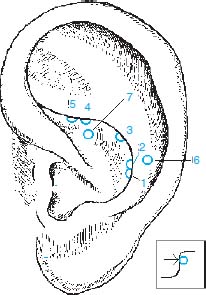
Fig. 6.1
1 Parathyroid Gland Point
2 Thyroid Gland Point
3 Thymus Gland Point
4 Endocrine Pancreas Point (Insulin Point)
5 Adrenal Gland Point (Cortisone Point)
6 Parenchymal thyroid gland
7 Parenchymal pancreas
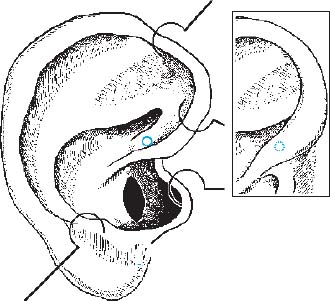
Fig. 6.2 Estrogen Point
Progesterone Point
Location:
• The right ear normally bears the Silver Point. This may vary with the syndrome and from person to person; hence, the needle metal of choice needs to be decided.
• About 4mm above the Kidney Point in the fold of the ascending helix.
Application:
• In the presence of hormonal and menopausal symptoms.
• May be combined with other points of the Hormonal Axis (see Auxiliary Lines, p. 291).
• During pregnancy this point is definitely contraindicated for nongynecologists.
Gonadotropin Point
Location:
• The right ear normally bears the Gold Point. This may vary with the syndrome and from person to person; hence, the needle metal of choice needs to be decided.
• On the anterior outer bulge of the antitragus, about 2mm inferior to its upper edge. When the antihelix is imagined as a snake, the antitragus forms the head of the snake, while the Gonadotropin Point forms the eye.
Application:
• Mainly during menopause in combination with the Estrogen Point.
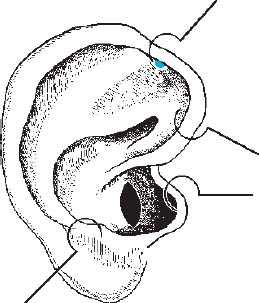
Fig. 6.3 Progesterone Point
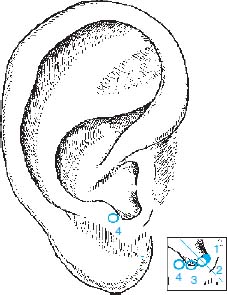
Fig. 6.4 Gonadotropin Point
1 Prolactin Point
2 ACTH Point
3 TSH Point
4 Gonadotropin Point
ACTH Point
Location:
• The right ear normally bears the Gold Point. In the anterior corner of the intertragic notch where the notch ascends to the tragus.
Application:
• ACTH stimulation; for example, in all cases of allergies.
• For supporting amalgam elimination use gold needle on the right ear.
• Corresponds to Point LR-13 of body acupuncture (p. 330).
TSH Point
Location:
• Just behind the ACTH Point (in posterior direction toward the antitragus).
• Requires stimulation (gold needle) or sedation (silver needle), depending on the syndrome.
Application:
• Predominantly diagnostic when latent hypothyroidism is suspected, supports the therapy in case of disease.
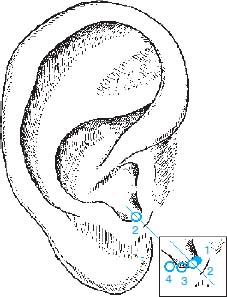
Fig. 6.5 ACTH Point
1 Prolactin Point
2 ACTH Point
3 TSH Point
4 Gonadotropin Point
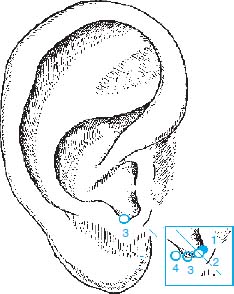
Fig. 6.6 TSH Point
Prolactin Point
Location:
• The right ear normally bears the Silver Point if children are desired (the needle metal of choice needs to be decided).
• Immediately above (superior to) the ACTH Point.
Application:
• When children are desired; because hyperprolactinemia is often present, use silver needle on the right ear.
• Supports lactation (use gold needle).
• Hormonal disorders, for example, oligomenorrhea or amenorrhea associated with hyperprolactinemia (use silver needle).
Endocrine Parathyroid Gland Point
Location:
• The right ear bears the Silver Point (use gold needle on the left ear).
• At the level of Point C5 in the antihelical wall, at the transition from the upper third to the middle third of the wall.
Application:
• Disorders of the parathyroid gland.
• Corresponds to Point TB-7 of body acupuncture (p. 328).
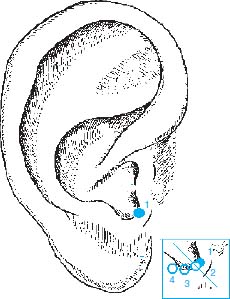
Fig. 6.7 Prolactin Point
1 Prolactin Point
2 ACTH Point
3 TSH Point
4 Gonadotropin Point
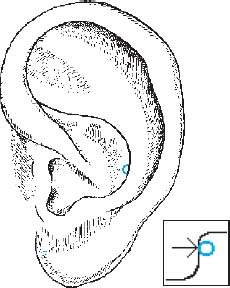
Fig. 6.8 Endocrine Parathyroid Gland Point
Thyroid Gland Point
Location:
• The right ear bears the Silver Point (for stimulation, use gold needle on the left ear).
• At the level of Point Zero in the antihelical wall, at the transition from the upper third to the middle third of the wall (at the intersection of the antihelical wall and a horizontal line through Point Zero; see Auxiliary Lines, p. 299).
Application:
• Disorders of the thyroid gland (use gold needle in case of hypothyroidism).
• Corresponds to Point TB-6 of body acupuncture (p. 328).
Thymus Gland Point
Location:
• The right ear bears the Silver Point (use gold needle on the left ear).
• At the level of Point T4 in the antihelical wall, at the transition from the upper third to the middle third of the wall.
Application:
• The most important Functional Point in ear acupuncture with an antifocal effect.
• Has anti-inflammatory, antirheumatic, and antiallergic effects.
• Stimulates the immune system.
• Needling this point inactivates all other pathological points for a short period of time; therefore, this point should always be needled last.
• Corresponds to Cardinal Point TB-5 of body acupuncture (p. 328).
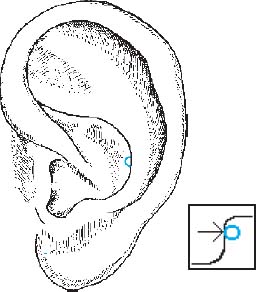
Fig. 6.9 Thyroid Gland Point
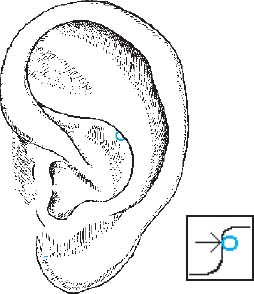
Fig. 6.10 Thymus Gland Point—corresponds to Cardinal Point TB-5 of body acupuncture
Endocrine Pancreas Point (Insulin Point)
Location:
• The right ear bears the Silver Point (use gold needle on the left ear).
• At the level of Points T10–T12 in the antihelical wall, at the transition from the upper third to the middle third of the wall.
Application:
• May be tried in diabetes mellitus (Insulin Point).
• Corresponds to Point TB-4 of body acupuncture (p. 328).
Adrenal Gland Point (Cortisone Point)
Location:
• The right ear bears the Silver Point (use gold needle on the left ear).
• At the level of Points T12–L1 in the antihelical wall, at the transition from the upper third to the middle third of the wall.
Application:
• The point has a cortisone effect and is, therefore, indicated in all allergic disorders.
• Corresponds to Point TB-3 of body acupuncture.
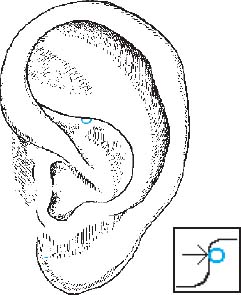
Fig. 6.11 Endocrine Pancreas Point (Insulin Point)
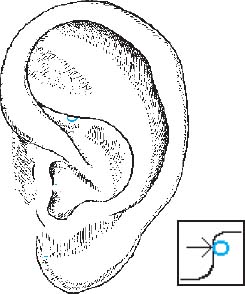
Fig. 6.12 Adrenal Gland Point (Cortisone Point)
Histamine Point (Allergy Point 1)
Location:
• The right ear bears the Silver Point (use gold needle on the left ear).
• At the most superior point of the ear (apex of the helix).
Application:
• Allergies, hay fever, asthma, etc.
• To be needled from the inner or outer side of the helix.
• Double function: a Focus Indicator Point for a severe focus of Type 1 (Histamine Type) and a point corresponding to Point BL-40 of body acupuncture (p. 326).
Prostaglandin E1 Point (PGE1 Point)
Location:
• The right ear bears the Gold Point.
• On the back of the ear, about 2mm away from the attachment site of the lobule.
Application:
• Rheumatoid diseases, hypotensive therapy, etc.
• Triple function: a Focus Indicator Point for a focus of Type 3 (PGE1 Type), a point with antirheumatic effect, and a Cardinal Point corresponding to Point GB–41 of body acupuncture (p. 330).
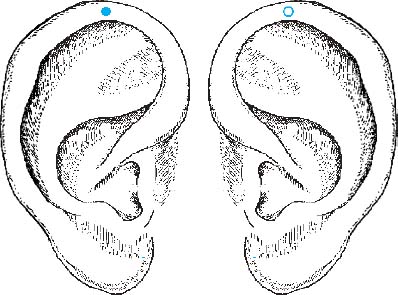
Fig. 6.13 Histamine Point (Allergy Point 1)
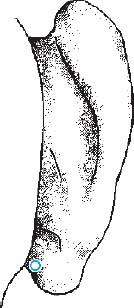
Fig. 6.14 Prostaglandin E1 Point (PGE1 Point)—corresponds to Cardinal Point GB–41 of body acupuncture
Prostaglandin E2 Point (PGE2 Point)
Location:
• The right ear bears the Gold Point.
• Near the PGE1 Point.
Application:
• Effect similar to that of the PGE1 Point.
Interferon Point
Location:
• The right ear bears the Silver Point (use gold needle in the left ear).
• In the corner of the supratragic notch.
Application:
• Anti-inflammatory.
• Increases immune defense.
• The most important point in children with fever (use laser frequency D for treatment).
• Corresponds to Cardinal Point SP-4 of body acupuncture (p. 322) and is therefore effective against diarrhea.
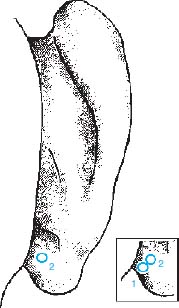
Fig. 6.15
1 Prostaglandin E1 Point (PGE1 Point)
2 Prostaglandin E2 Point (PGE2 Point)
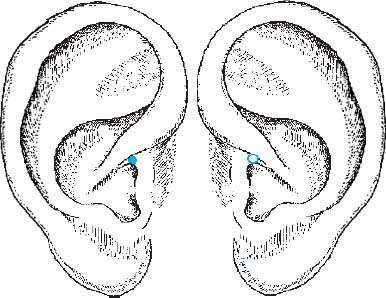
Fig. 6.16 Interferon Point—corresponds to Cardinal Point SP-4 of body acupuncture
Renin/Angiotensin Point
Location
• The right ear bears the Silver Point in patients with hypertension.
• The right ear bears the Gold Point in patients with hypotension.
• Located 2mm above the Kidney Point in the rim of the ascending helix.
Application:
• Antihypertensive effect when used in combination with the Beta-1-Receptor Point (use silver needle on the right ear, gold needle on the left ear) and the Hypothalamus Point (use silver needle on the right ear).
Beta-1-Receptor Point (Beta-Blocker Point According to Bahr)
Location:
• The right ear bears the Silver Point (use gold needle on the left ear).
• Partly hidden in the groove of the ascending helix, on the Auxiliary Line through Point Zero and Point C7/T1 (p. 297).
Application:
• Reduces activity of beta-1-receptors, has an antihypertensive effect.
• Pharmaceutical analogue: metoprolol.
• During antihypertensive therapy, it makes sense to use it in combination with the Renin/Angiotensin Point (use silver needle on the right ear) and with the Hypothalamus Point (use silver needle on the right ear), perhaps also with the Diazepam Analogue Point or with the Depression Point.
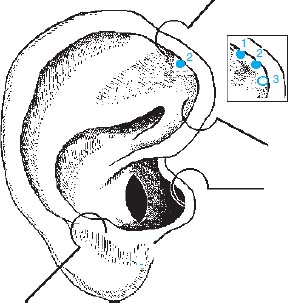
Fig. 6.17 Renin/Angiotensin Point
1 Progesterone Point
2 Renin/Angiotensin Point
3 Kidney Point
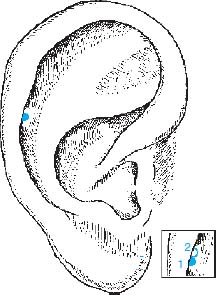
Fig. 6.18 Beta-1-Receptor Point
1 Beta-1-Receptor Point
2 Beta-2-Receptor Point
Beta-2-Receptor Point (Beta-Mimetic Point According to Bahr)
Location:
• The right ear bears the Gold Point.
• Immediately superior to the Beta-1-Receptor Point.
Application:
• Bronchospasmic conditions, bronchial asthma.
• Stimulates beta-2-receptors.
• Has a broncholytic effect.
• Pharmaceutical analogue: fenoterol.
• Corresponds to Point ST-40 of body acupuncture (p. 322).
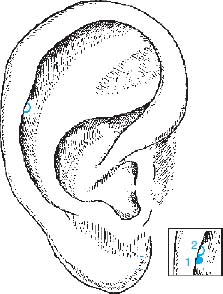
Fig. 6.19 Beta-2-Receptor Point
1 Beta-1-Receptor Point
2 Beta-2-Receptor Point
Diazepam Analogue Point (Valium Point According to Bahr)
Location:
• The right ear bears the Silver Point (use gold needle on the left ear).
• On the tragus, about 2mm away from the edge of the tragus and just inferior to the middle of the tragus.
Application:
• Sedative and relaxing effects.
• Often leading in the treatment of lower abdominal and urinary bladder symptoms (irritable bladder); useful in combination with the Spleen Point as a second Anxiety Point (use gold needle).
• Effect identical to that of Cardinal Point KI-6 of body acupuncture (p. 326).
Barbiturate Analogue Point
Location:
• The right ear bears the Silver Point (use gold needle on the left ear).
• Partly hidden in the groove of the descending helix at the level of Point C7 (horizontal line through Point C7, see Auxiliary Lines, p. 287); located within the Zone of Origin of Sympathetic Nuclei.
• Localization identical to that of the Caffeine Analogue Point (use the opposite needle metal).
Application:
• Important point, for example, in insomnia.
• May be combined with all other Psychotropic and Medication Analogue Points.
• Corresponds to Point ST-36 of body acupuncture (p. 322).
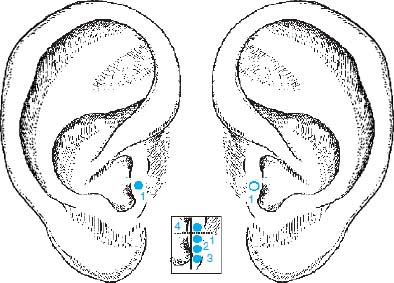
Fig. 6.20
1 Diazepam Analogue Point—corresponds to Cardinal Point KI-6 of body acupuncture
2 Nicotine Analogue Point
3 Pineal Gland Point
4 Phosphate Analogue Point
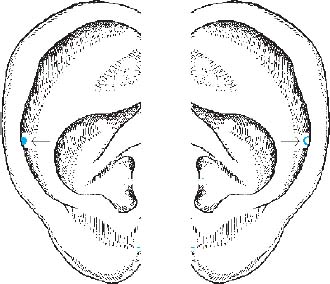
Fig. 6.21
Barbiturate
Analogue Point
Caffeine Analogue Point
Location:
• The right ear bears the Gold Point.
• Localization identical to that of the Barbiturate Analogue Point (use opposite needle metal).
Application:
• Corresponds to Point ST-36 of body acupuncture (p. 322).
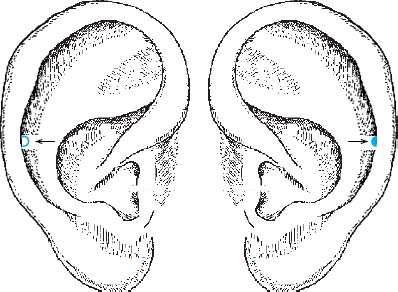
Fig. 6.22 Caffeine Analogue Point
Nervous Organ Points—Overview
Location:
The sympathetic nerve fibers of the liver and gall bladder are represented in the Zone of Sympathetic Trunk at the level of Points T5–T9. The Nervous Liver Point and the Nervous Gall Bladder Point are also located here, very close together (for both points, use silver needle on the right ear).
The sympathetic nerve fibers of the stomach and duodenum are represented in the Zone of Sympathetic Trunk at the level of Points T6–T9. The Nervous Stomach Point (use gold needle in the left ear) and the Nervous Duodenum Point (use gold needle in the right ear) are also located here.
Application:
• Syndromes affecting individual digestive organs (e.g., gastritis, duodenal ulcer).
• The Nervous Liver Point corresponds to Point LR-3 of body acupuncture (p. 330) and is also called Anger Point.
Warning: As a rule, the Nervous Points—despite their strong mental effects-follow more the anatomical localization of the organ (assigned to the sympathetic trunk). This means, the choice of metal for a left-handed person is the same as for a right-handed person.
Anger Point Syn. Nervous Liver Point
Location:
• In the Sympathetic Trunk Zone at the level of Points T5–T9 (use silver needle on the right ear).
Application:
• Corresponds to the Nervous Liver Point (representing the sympathetic trunk fibers that innervate the liver), and also to Point LR-3 of body acupuncture (p. 330; in TCM there is a special connection between the liver and the emotional state of anger). Needling this point will support any treatment that aims at strengthening the liver as an organ.
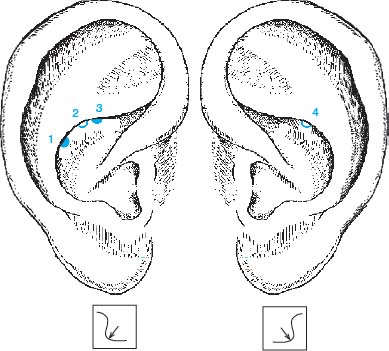
Fig. 6.23
1 Stellate Ganglion Point
2 Nervous Duodenum Point
3 Nervous Liver Point (Anger Point) and Gall Bladder Point
4 Nervous Stomach Point
Psychotropic Points—Overview
There is, of course, some overlap between the Psychotropic Points and the Medication Analogue Points.
All Psychotropic Points as well as all Medication Analogue Points may be combined with one another without incurring side effects.
For a better understanding, those points found as Silver Points on the right (dominant) ear are illustrated there as Silver Points. However, most of the points are pricked preferably on the left (nondominant) ear with a gold needle (all descriptions are for right-handed persons; needle the opposite ear in a left-handed person).
Master Omega Point (Bromazepam Analogue Point)
Location:
• The right ear bears the Gold Point.
• On the inferior portion of the lobule, about 4mm away from the edge.
• Forms the Omega Axis together with Omega Point I and Omega Point II (see Auxiliary Lines, p. 289).
Application:
• Possibly indicating a field of mental disturbance.
• Medication assigned to this point: bromazepam.
• Corresponds to Points SP-21 (p. 322) and CV-17 (p. 332) of body acupuncture.
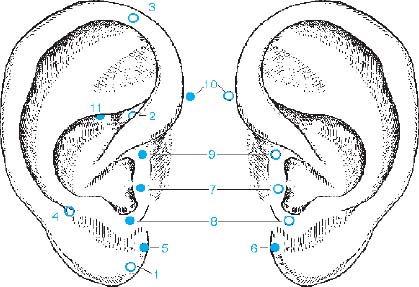
Fig. 6.24
1 Master Omega Point
2 Omega Point I
3 Omega Point II
4 Depression Point
5 Anxiety Point
6 Worry Point
7 Diazepam Analogue Point
8 Aggression Point
9 Frustration Point
10 Psychotherapy Point according to Bourdiol
11 Anger Point
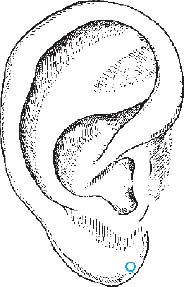
Fig. 6.25 Master Omega Point (Bromazepam Analogue Point)
Omega Point I
Location:
• The right ear bears the Gold Point, possibly indicating a mercury load.
• In the superior concha, in the middle of the triangle formed by ascending helix and antihelix.
Application:
• Prick with gold needle as a supporting measure in case of mercury load or during amalgam elimination (perhaps in combination with ACTH Point, Thymus Gland Point).
• An autonomic Functional Point (Hypogastric Plexus Point).
• Corresponds to Point CV-12 of body acupuncture (p. 332, Focus Indicator Point for mercury load).
Omega Point II
Location:
• The right ear bears the Gold Point.
• On the ascending helix, on the line running through Omega Point I and Master Omega Point.
Application:
• Mental problems related to a person’s interaction with other people and the environment.
•
Stay updated, free articles. Join our Telegram channel

Full access? Get Clinical Tree


